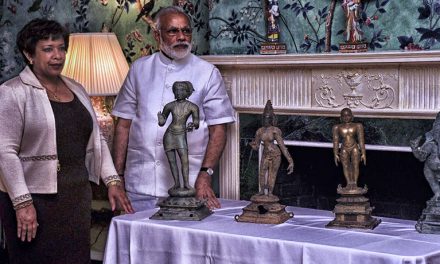India is seeking UNESCO support for an international campaign to recover its priceless antiquities that were once taken away from the country in foreign invasions, a senior official of the Archaeological Survey of India said. “As efforts so far to reclaim stolen treasures have proved futile, UNESCO support is required for launching an international campaign to achieve the end,” ASI Director General Gautam Sengupta said.
Sengupta, who attended the Cairo conference of archaeological heads of countries last month, said India had expressed its wish to get back the stolen treasures like the exquisite Kohinoor, taken away by the British and now in the Tower of London, besides Birmingham Buddha, Amravati railings, Saraswati idol (stolen from Bhoj temple) and many other lost valuables.
He said the whereabouts of fabled Peacock throne, looted during raid by Nadir Shah and taken to Persia, were not immediately available.
“Information is that most of the precious antique items which we lost in raids, attacks or loots during foreign invasions in the pre-independence period are spread over museums, mostly in European countries,” he said.
Sengupta said the Cairo conference called for a suitable international law to ban export or ownership of stolen antiquities acquired after 1970.
This would help in preventing acquisition of stolen treasures of any particular country.
The ASI chief said Egypt had incurred huge loss in terms of stolen antiquities, which it desperately seeks to get back.
“Not only India, various other countries like Mexico, Peru, China and Bolivia, Cyprus and Guatemala also voiced the same concern to get back their stolen and looted antiquities and to join the international campaign,” Sengupta said.
The Peacock throne inlaid with precious stones was created in the 17th century for Mughal emperor Shah Jahan, who had placed the Kohinoor diamond and kept it at the Diwan-i-aam in his imperial capital of Delhi.
It was taken away by invader Nadir Shah to Persia in 1739 and after his assassination in 1747 the original throne was lost in the chaos that ensued.
The Saraswati image is believed to have been at a temple at Bhojsala set up by Raja Bhoj (1010-1053), a Parmar king who spent his life institutionalizing culture, creating knowledge banks and developing centers for art and spirituality, in the town of Dhar in Madhya Pradesh.
The image is now at the British Museum in London.
The Birmingham Buddha, the largest surviving Buddha image of ancient India, was discovered in 1861 from the site of a monastery at Sultanganj in Bihar during a railway construction. It is now at the City Museum and Art Gallery in Birmingham.
The Amravati railings belong to the Amravati stupa of Andhra Pradesh built between the second century BC and third century AD.
In the late 19th century most of the main Amravti sculptures were taken away from the site and sent to museums. Many are in the British Museum.











